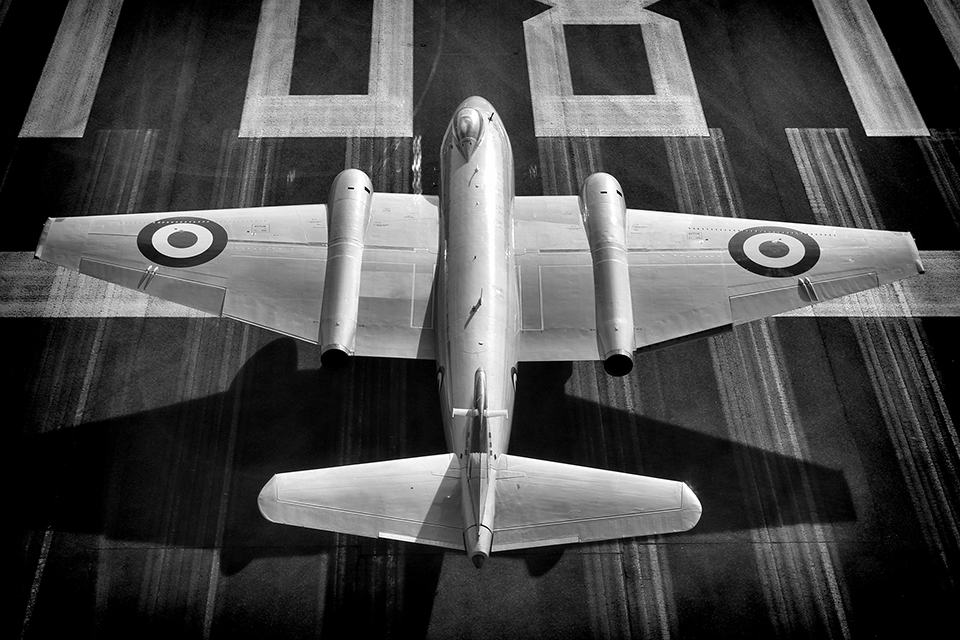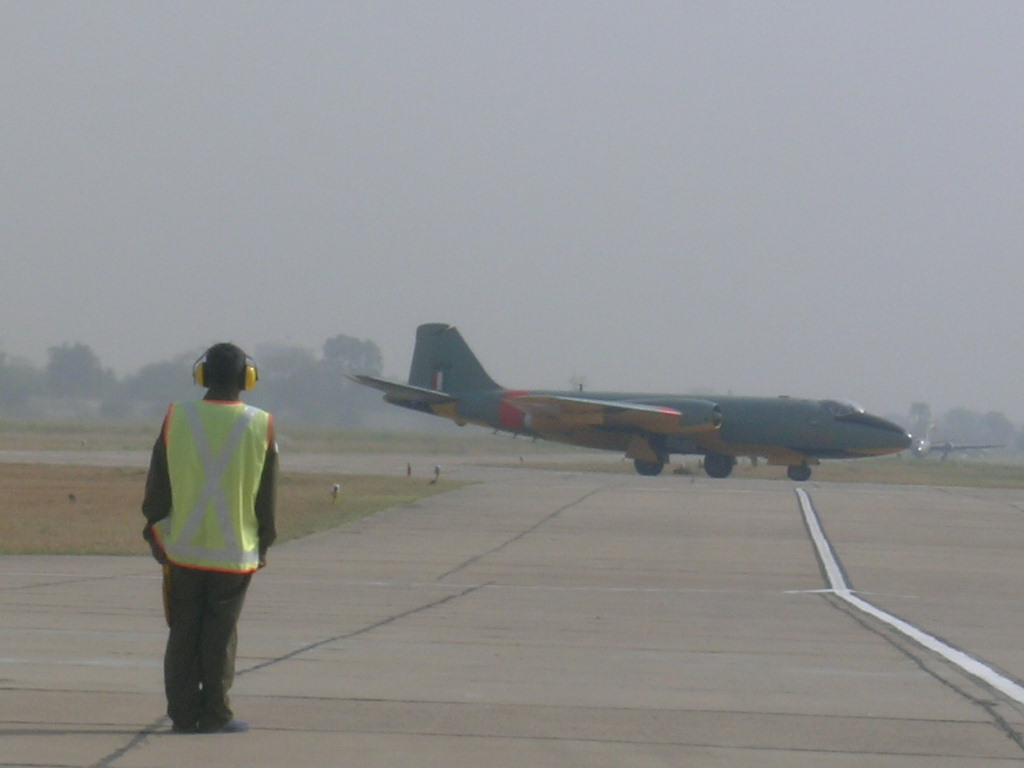
After accepting a restored World War II DC-3 Dakota aircraft earlier this year as a gift from Indian politician Rajeev Chandrasekhar, the Indian Air Force is now considering a second gift for its heritage squadron — an English Electric Canberra, a version of which saw half a century of Indian service before its retirement in 2007. The team that restored the Dakota before it was gifted to the IAF has sent a proposal to the IAF Headquarters based on an already flying specimen of the Canberra based in the UK.
Mike Edwards MBE, chief advisor to the IAF Vintage Flight told Livefist about the proposal. Edwards has led restoration projects in the United Kingdom that have seen the IAF now operate three aircraft in its Hindon-based vintage squadron: a de Havilland Tiger Moth, a North American T-6G Harvard and most recently, the DC-3 Dakota. While IAF-funded restoration work has hit a speedbump owing to budgetary constraints, the Canberra proposal could be pushed through owing to the fact the IAF will have to commit nearly no funds.
“The offer of the Canberra being arranged with Rajeev Chandrasekhar has been discussed with the IAF but is awaiting the next step which is a visit by the IAF UK Air Adviser, Air Cmde Anil Sabharwal. He played a big part in the Dakota becoming part of IAF with multiple visits during the restoration and being in the aircraft during the test flying phase,” Edwards told Livefist in an e-mail interview.
The Canberra is owned by Suzannah Harvey, a former fashion model and modelling entrepreneur now CEO of the Cotswold Airport, Europe’s largest privately-owned general aviation hub. Cotswold Airport in Gloucestershire is where the IAF’s Dakota was stored until the IAF was cleared to accept the aircraft as a gift from Rajeev Chandrasekhar, who formally joined India’s ruling party the BJP earlier this year. The Dakota was flown to Reflight in Coventry for work that prepared it for delivery to the IAF earlier this year.
“In addition, I know Suzannah as the Hawker Hunter came from her that I formed the Royal Jordanian Air Force Hashemite Heritage Flight. When Suzannah said there was not the business case to run the Canberra anymore post Shoreham Hunter Air show crash when all civilian ex military jets were grounded and she was concerned this serviceable aircraft might be left to decay, that is when Rajeev and I came up with the idea of it coming to India,” Edwards said.

The Indian Air Force operated over 60 Canberras primarily in the bomber role, but also for photo-reconnaissance over half a century, with prominent roles in all of India’s major wars and conflicts, including the 1962, 1965 and 1971 wars. Operated only for photo-reconnaissance during its final years, the Canberras were retired from the Agra home base in May 2007.

“So the IAF get a free aircraft to celebrate the type that did 50 amazing years of service for IAF. If they won’t take it then this particular example will never fly again due to the UK, for the time being, not focusing on the ex military jets. There is still a massive thirst for Spitfire, Hurricane Harvard, Dakota Tigermoth etc. Air shows in UK still 2nd most attended public events after football!” Edwards said.
Suzannah Harvey’s Canberra is a flying aircraft. Edwards says any other example of the jet will require a huge restoration project with large cost implications — not impossible, but from a funding perspective this is the only realistic option for IAF to have a Canberra, he believes.
The Canberra on offer as a gift to the IAF is on the British civilian register. It needs certification renewed and the extras that the IAF will require as they did for the Dakota.
“The Australian Air Force have a Canberra in their vintage flight. The design is so good that NASA use 3 Canberras for their high altitude work. Even though this is an old aircraft she could be used in such a role by the Indian scientific community being able to take a large payload to great heights,” Edwards said.
Asked about concerns over any cost commitments that could deter the IAF from looking at the Canberra, Edwards said, “It is offered as a gift. There is no up front costs to speak of beyond paperwork costs and some inspections to up date. Having done the Dakota, I know the IAF, quite rightly, will want to upgrade it back to military specs like live ejection seats and GPS navigation etc. It is quite right that it should be at IAF specs but it will be a tiny amount of funding.”
On whether the Canberra would be considered vintage enough, considering it retired from active IAF service only a decade ago, Edwards said, “The Canberra is vintage in anyone’s book. It was the first operational jet bomber being designed in 1944. That is vintage. The only reason it stayed in IAF service until so recently was it was such a good design and many that followed it were not as good as the faithful Canberra.In a lovely twist of fate it was IAF chief Air Chief Marshal Fali Major who took the last salute as the Canberra bowed out of service with the IAF but it was ACM Major who took my proposal for the IAF Vintage Flight and made it happen through his own personal drive to see IAF history preserved.”
The history of the Canberra in Indian service is one of legend. They entered service in 1957 as the IAF’s only bomber force. No. 35 Squadron were the first jet aircraft of the IAF to use weapons in anger. On 18 Dec 1961 the squadron carried out high accurate bombing of Dabolim airfield against the Portuguese with no civilian causalities. By the 20th Goa had been reclaimed. In 1961 the Canberras were the first IAF Fighter Bomber units to take part in UN ops, this time in the Congo.
In 1962, the IAF had their hand’s tied but the Canberras were one of the few IAF units to take part in the Chinese conflict flying reconnaissance missions to great effect. In 1965 the Canberras carried out the role as the IAF bomber force especially in the famous “Raid of Badin” to take out the enemy radars. For the war effort many crew, were awarded Maha Vir Chakras, Vir Chakras.
1971 saw four MVCs, a dozen VCs for the Canberras with the Karachi oil refinery raids being the most well known. The Canberra coped well for the changing face of air operations to become expert in electronic warfare, maritime strike and photo reconnaissance. The latter being used in the Kargil war where Sqn Ldr Alagaraja Perumal did a great job bringing the aircraft back home after losing an engine to ground fire.

Such a shame that post Shoreham, so many people are unable to fly their vintage aircraft.
Yes it was a terrible crash that killed a number of people, but it really was a one off, probably caused by pilot error, and not a fault in the aircraft.